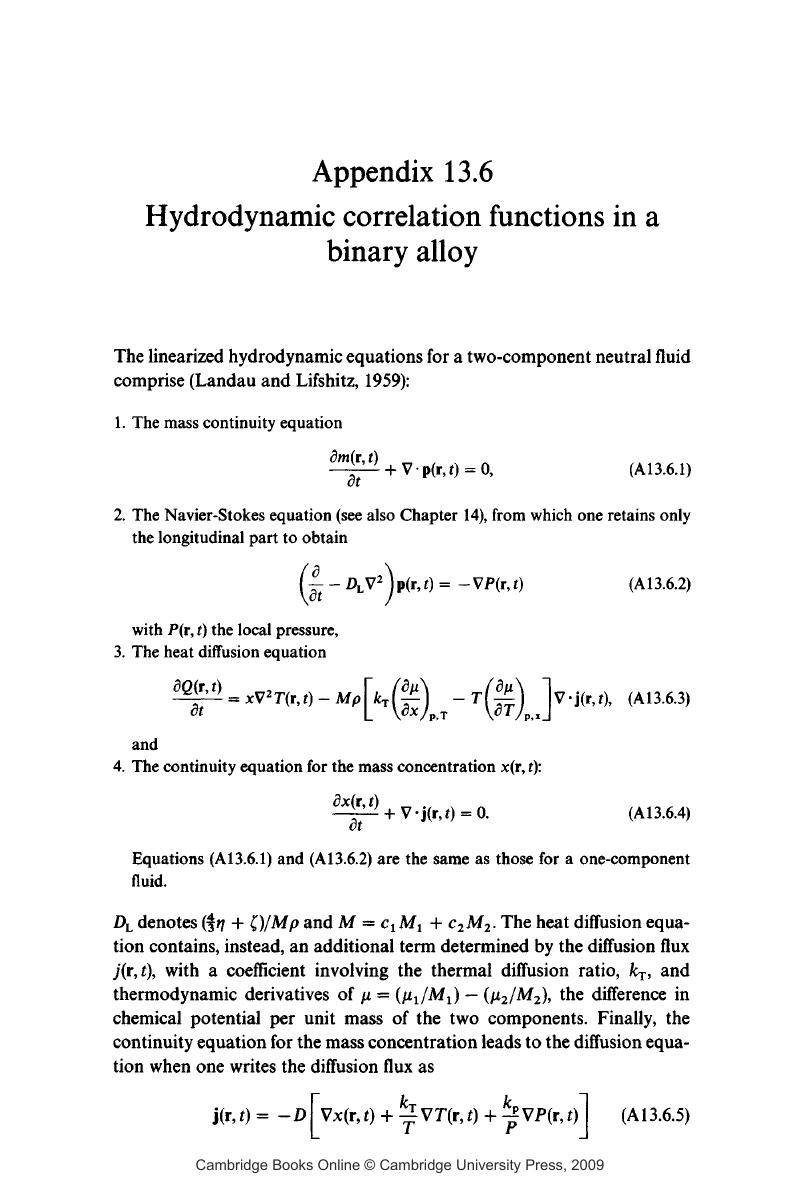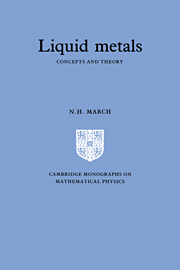Book contents
- Frontmatter
- Contents
- Preface
- 1 Outline
- 2 Pair correlation function and structure factor of ions
- 3 Thermodynamics
- 4 Electron screening and effective ion-ion interactions
- 5 Interionic forces and structural theories
- 6 Statistical mechanics of inhomogeneous systems and freezing theory
- 7 Electronic and atomic transport
- 8 Hydrodynamic limits of correlation functions and neutron scattering
- 9 Critical behaviour
- 10 Electron states, including critical region
- 11 Magnetism of normal and especially of expanded liquid metals
- 12 Liquid-vapour surface
- 13 Binary liquid-metal alloys
- 14 Two-component theory of pure liquid metals
- 15 Shock-wave studies
- 16 Liquid hydrogen plasmas and constitution of Jupiter
- Appendices
- 2.1 Fluctuation theory derivation of S(0) in terms of compressibility
- 3.1 Percus-Yevick hard sphere solution for direct correlation function
- 3.2 Weeks-Chandler-Andersen (WCA) approximation to structure factor
- 5.1 Pressure dependence of pair function related to three-particle correlations
- 5.2 Conditions to be satisfied by thermodynamically consistent structural theories
- 5.3 Gaussian core model and Kirkwood decoupling of triplet correlations
- 5.4 Specific heats of liquids in terms of higher-order correlation functions
- 5.5 Inversion of measured structure, constrained by pseudopotential theory, to extract ion-ion interaction
- 6.1 Vacancy formation energy evaluated in a hot (model) crystal
- 6.2 Vacancy formation energy related to Debye temperature
- 7.1 Inverse transport theory for noninteracting electrons
- 8.1 Method of fluctuating hydrodynamics
- 8.2 Asymptotic behaviour of other Green-Kubo time correlation functions
- 8.3 Dynamics of S(k, ω) included through self-function Ss(k, ω)
- 8.4 Fourth moment theorem for dynamical structure factor
- 8.5 One-dimensional barrier crossing: Kramers' theory
- 8.6 Mode-coupling and velocity field methods
- 9.1 Ornstein-Zernike treatment of critical correlations
- 9.2 Homogeneity, scaling, and an introduction to renormalization group method
- 9.3 Compressibility ratios and thermal pressure coefficients of simple monatomic liquids from model equations of state
- 9.4 Mode coupling applied to critical behaviour
- 9.5 Proof of Wiedemann-Franz law up to metal-insulator transition for Fermi liquid model
- 10.1 Plasmon properties as function of phenomenological relaxation time
- 11.1 Heavy Fermion theory
- 13.1 Conformal solution theory: thermodynamics and structure
- 13.2 Results for concentration fluctuations from quasi-chemical approximation
- 13.3 Density profiles, direct correlation functions, and surface tension of liquid mixtures
- 13.4 Relation of surface segregation phenomenology to first-principles statistical mechanics
- 13.5 Long-time behaviour of correlation functions in binary alloys
- 13.6 Hydrodynamic correlation functions in a binary alloy
- 13.7 Metallic binary liquid-glass transition
- 13.8 Haeffner effect, electromigration, and thermal transport
- 13.9 Theory of disorder localization of noninteracting electrons
- 14.1 Phonon-plasmon model
- 14.2 Response functions for mass densities
- 14.3 Quantum hydrodynamic limit of two-component theory
- 14.4 Evaluation of transport coefficients
- 14.5 Electron-ion structure factor in a nonequilibrium situation
- 14.6 Relations between long-wavelength limit structure factors in binary metallic alloys
- 16.1 Integral equations for correlations in liquid metals, especially hydrogen
- 16.2 Quantum Monte Carlo calculations of ground state of solid hydrogen
- References
- Index
13.6 - Hydrodynamic correlation functions in a binary alloy
Published online by Cambridge University Press: 19 January 2010
- Frontmatter
- Contents
- Preface
- 1 Outline
- 2 Pair correlation function and structure factor of ions
- 3 Thermodynamics
- 4 Electron screening and effective ion-ion interactions
- 5 Interionic forces and structural theories
- 6 Statistical mechanics of inhomogeneous systems and freezing theory
- 7 Electronic and atomic transport
- 8 Hydrodynamic limits of correlation functions and neutron scattering
- 9 Critical behaviour
- 10 Electron states, including critical region
- 11 Magnetism of normal and especially of expanded liquid metals
- 12 Liquid-vapour surface
- 13 Binary liquid-metal alloys
- 14 Two-component theory of pure liquid metals
- 15 Shock-wave studies
- 16 Liquid hydrogen plasmas and constitution of Jupiter
- Appendices
- 2.1 Fluctuation theory derivation of S(0) in terms of compressibility
- 3.1 Percus-Yevick hard sphere solution for direct correlation function
- 3.2 Weeks-Chandler-Andersen (WCA) approximation to structure factor
- 5.1 Pressure dependence of pair function related to three-particle correlations
- 5.2 Conditions to be satisfied by thermodynamically consistent structural theories
- 5.3 Gaussian core model and Kirkwood decoupling of triplet correlations
- 5.4 Specific heats of liquids in terms of higher-order correlation functions
- 5.5 Inversion of measured structure, constrained by pseudopotential theory, to extract ion-ion interaction
- 6.1 Vacancy formation energy evaluated in a hot (model) crystal
- 6.2 Vacancy formation energy related to Debye temperature
- 7.1 Inverse transport theory for noninteracting electrons
- 8.1 Method of fluctuating hydrodynamics
- 8.2 Asymptotic behaviour of other Green-Kubo time correlation functions
- 8.3 Dynamics of S(k, ω) included through self-function Ss(k, ω)
- 8.4 Fourth moment theorem for dynamical structure factor
- 8.5 One-dimensional barrier crossing: Kramers' theory
- 8.6 Mode-coupling and velocity field methods
- 9.1 Ornstein-Zernike treatment of critical correlations
- 9.2 Homogeneity, scaling, and an introduction to renormalization group method
- 9.3 Compressibility ratios and thermal pressure coefficients of simple monatomic liquids from model equations of state
- 9.4 Mode coupling applied to critical behaviour
- 9.5 Proof of Wiedemann-Franz law up to metal-insulator transition for Fermi liquid model
- 10.1 Plasmon properties as function of phenomenological relaxation time
- 11.1 Heavy Fermion theory
- 13.1 Conformal solution theory: thermodynamics and structure
- 13.2 Results for concentration fluctuations from quasi-chemical approximation
- 13.3 Density profiles, direct correlation functions, and surface tension of liquid mixtures
- 13.4 Relation of surface segregation phenomenology to first-principles statistical mechanics
- 13.5 Long-time behaviour of correlation functions in binary alloys
- 13.6 Hydrodynamic correlation functions in a binary alloy
- 13.7 Metallic binary liquid-glass transition
- 13.8 Haeffner effect, electromigration, and thermal transport
- 13.9 Theory of disorder localization of noninteracting electrons
- 14.1 Phonon-plasmon model
- 14.2 Response functions for mass densities
- 14.3 Quantum hydrodynamic limit of two-component theory
- 14.4 Evaluation of transport coefficients
- 14.5 Electron-ion structure factor in a nonequilibrium situation
- 14.6 Relations between long-wavelength limit structure factors in binary metallic alloys
- 16.1 Integral equations for correlations in liquid metals, especially hydrogen
- 16.2 Quantum Monte Carlo calculations of ground state of solid hydrogen
- References
- Index
Summary

- Type
- Chapter
- Information
- Liquid MetalsConcepts and Theory, pp. 422 - 425Publisher: Cambridge University PressPrint publication year: 1990

